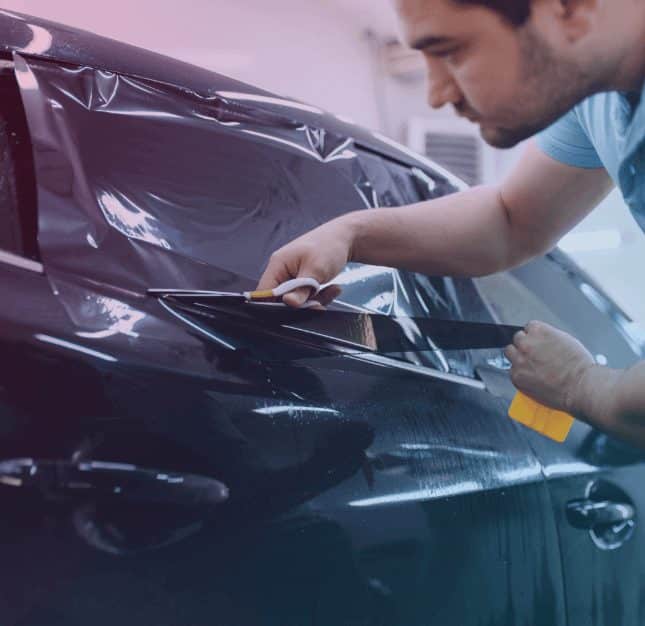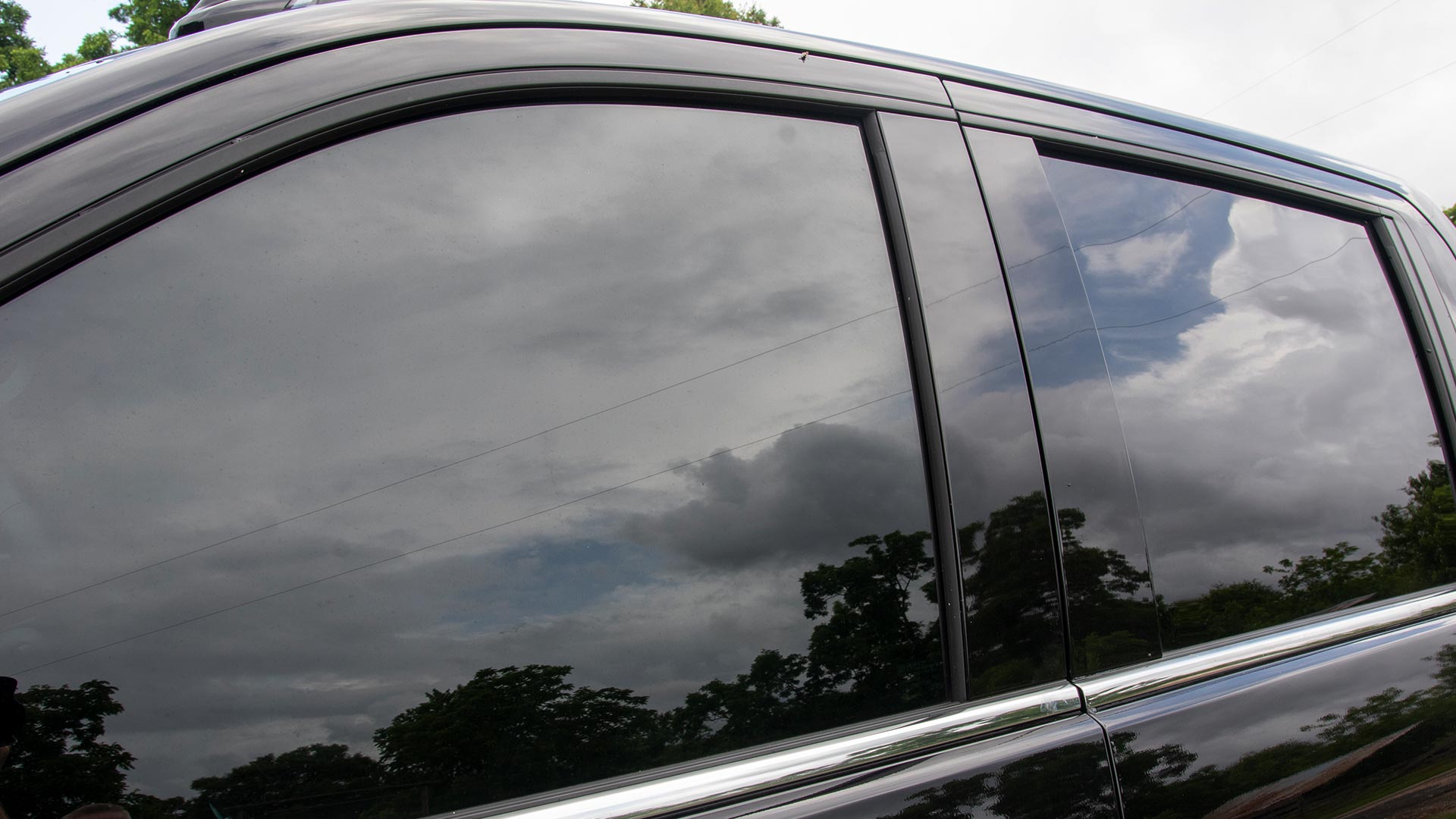A Comprehensive Guide to Recognizing Auto Window Color and Its Benefits
Vehicle home window tinting serves even more than simply an aesthetic objective for automobiles. It provides numerous kinds, each with distinctive functions and advantages. Comprehending these options, in addition to legal laws and maintenance tips, is important for any kind of automobile owner. The benefits may significantly enhance driving convenience and vehicle long life. As one checks out the subtleties of window tinting, the inquiry develops: what sort of tint is best matched for private demands?
Understanding Automobile Home Window Tint: What It Is and How It Functions
Car home window tint offers as a protective obstacle that boosts car aesthetic appeals while providing useful benefits. This thin movie is related to the indoor surface of auto windows, minimizing glare and blocking harmful ultraviolet (UV) rays from the sun. By filtering system sunlight, automobile home window tint assists to control the indoor temperature of the lorry, leading to boosted convenience for passengers and minimized dependence on air conditioning.Additionally, it protects the automobile's interior from fading, maintaining both upholstery and dashboard materials. The color can additionally enhance privacy, making it a lot more hard for outsiders to see inside the automobile. Moreover, specific kinds of home window tint can enhance security; in case of a mishap, the film assists hold shattered glass together, lowering the threat of injury from flying fragments. Generally, automobile window tint offers both visual and practical purposes, making it a prominent option among car owners.
Kinds Of Window Color: An Overview of Options
When considering home window color options, several types are available, each with unique characteristics. Colored, metalized, and ceramic home window colors use varying levels of warm denial, UV protection, and aesthetic allure. Comprehending these differences can assist lorry owners make notified selections based upon their preferences and demands.
Colored Window Color
Dyed home window tint stands for a popular selection among vehicle proprietors seeking a reliable and cost effective way to enhance their car's looks and privacy. This sort of tint is produced by positioning a layer of dye in between an adhesive layer and a safety layer, resulting in a darkened look that decreases glare and improves visual convenience. While colored home window color efficiently obstructs harmful UV rays, it may not provide the very same degree of heat denial as other tint kinds. Additionally, its shade can fade over time, possibly lessening its performance. Regardless of these downsides, dyed home window color stays popular for its cost-effectiveness and capability to provide a smooth, elegant appearance to numerous vehicle designs.
Metalized Home Window Tint
Metalized home window color offers a balance of design and capability, making it a prominent option amongst auto proprietors. This kind of color includes metallic bits within the film, enhancing both aesthetic appeal and heat denial. The reflective top quality of metalized color helps to lower glow and enhance privacy, while likewise offering UV protection, which safeguards the vehicle's inside. Furthermore, metalized home window tint can enhance home window stamina, potentially preventing smashing throughout crashes. Nonetheless, it is essential to note that the metallic parts can hinder electronic signals, such as general practitioner and cellular phone function. Generally, metalized window color supplies an effective remedy for those looking for a combination of sunlight, appearance, and durability protection for their automobiles.
Ceramic Window Color
Ceramic window tint represents an advanced option in the range of vehicle window films, offering distinctive advantages over conventional tints. Unlike colored or metalized films, ceramic tints make use of sophisticated ceramic fragments, which properly turn down warmth and UV rays without jeopardizing visibility. This innovation guarantees that vehicles stay cooler, reducing reliance on cooling and improving gas performance. Additionally, ceramic home window colors are less likely to interfere with digital tools, such as GPS or mobile signals, making them a sensible choice for contemporary lorries. Moreover, their toughness and scratch resistance add to a much longer life-span contrasted to other sorts of colors. In general, ceramic home window color supplies premium efficiency, convenience, and defense, making it a recommended choice for critical automobile owners.
Benefits of Automobile Window Tint: Beyond Aesthetics
While numerous individuals associate car window tint with enhanced style, its advantages expand far past plain appearances. One substantial advantage is warmth decrease; window tint can obstruct approximately 99% of harmful UV rays, protecting and maintaining the indoor cooler upholstery from fading. This not just enhances convenience during warm climate however likewise reduces dependence on a/c, resulting in boosted fuel efficiency.In addition, auto home window color offers an included layer of personal privacy and safety. Tinted home windows make it challenging for outsiders to see inside the automobile, which can discourage theft and shield valuables. In addition, several colors reinforce the glass, reducing the likelihood of shattering in case of a crash, therefore boosting safety.In addition to these useful advantages, car home window tint can also contribute to glare reduction, improving exposure for drivers and passengers alike. This diverse method to convenience and safety makes home window tint a beneficial financial investment for vehicle owners.
Lawful Factors To Consider: Tinting Laws by State
Prior to committing to automobile home window tint, automobile proprietors need to browse a complex landscape of tinting guidelines that differ by state. Each state has particular regulations governing the allowable degrees of tint darkness and reflectivity for different home windows, including windshields, front side windows, and rear home windows. These laws frequently include noticeable light transmission (VLT) portions, which determine how much light can travel through the colored glass.Some states allow darker tints on rear windows while restricting front side and windshield tints for security factors. In addition, particular states might require a certificate from the maker to validate conformity with tinting regulations. Breaking these guidelines can cause penalties, obligatory removal of the tint, or both. Subsequently, it is essential for vehicle owners to research their state's laws thoroughly to guarantee legal compliance before mounting home window color. This diligence can conserve money and time over time.
Picking the Right Color: Factors to Think about
When selecting the appropriate window color for an automobile, a number of important aspects enter into play. Tint darkness levels, UV protection ratings, and conformity with legal guidelines are essential considerations to ensure both aesthetics and performance. Assessing these facets will help individuals make an educated choice that satisfies their demands and adheres to local legislations.
Color Darkness Levels
Picking the proper color darkness degree is important for accomplishing the preferred equilibrium in between looks and performance in auto home window tinting. Different states have differing lawful policies relating to tint darkness, which can influence the selection. Generally, colors are gauged in percents, with lower percents suggesting darker tones. Darker colors provide increased personal privacy and a streamlined appearance yet can decrease presence, especially during the night. Conversely, lighter colors maintain a more open feeling, ensuring appropriate visibility while still offering some warmth and glow reduction. When making a choice, people ought to consider their driving routines, neighborhood laws, and personal choices. Inevitably, the ideal color darkness level enhances the automobile's appearance while ensuring safety and compliance with legal requirements.
UV Defense Ranking
Tint darkness degrees play a significant role in the general efficiency of vehicle home window tinting, but another essential aspect to examine is the UV defense ranking of the chosen tint. This rating suggests the portion of unsafe ultraviolet rays that the color can block. Top notch tints typically give 99% or even more UV defense, safeguarding passengers and the vehicle's inside from sunlight damages. Davinci of Michigan. Prolonged exposure to UV rays can lead to skin problems and fading of furniture, making a high UV defense ranking crucial for wellness and long life. When picking window color, consumers should prioritize this score together with darkness degrees to guarantee optimum comfort and safety and security while driving. Understanding these factors help in making an educated decision when spending in automobile window tinting
Lawful Laws Conformity
Comprehending regional lawful guidelines is essential for anybody considering car home window tinting. Each state or area has details legislations governing the allowed degrees of tint darkness and reflectivity for various windows. These laws commonly specify the noticeable light transmission portion, figuring out just how much light can travel through the colored glass. Non-compliance can lead to penalties, required removal of the color, or issues throughout lorry evaluations. Additionally, some locations may have restrictions on making use of specific tinting products, needing customers to pick items that satisfy safety criteria. It is vital for car proprietors to investigate their local laws completely prior to selecting window color to guarantee conformity and stay clear of potential legal issues.

Installment Refine: do it yourself vs. Professional Services
Exactly how does one make a decision in between a do it yourself installment and working with specialist solutions for auto window tinting? The option commonly pivots on spending plan, experience, and wanted outcomes. A do it yourself strategy can be cost-effective, allowing people to reduce labor costs. However, it requires a particular degree of skill and knowledge about the tinting procedure. Those that are precise and client might discover success with DIY packages offered in the market.Conversely, expert services provide know-how and top quality materials, ensuring a remarkable coating. Professionals often ensure their job, giving peace of mind versus potential concerns such as bubbling or peeling. In addition, they are acquainted with regional regulations pertaining to tinting, which can be complicated for the typical car owner.Ultimately, the decision mirrors a balance between price, personal ability, and the expected top quality of the tinting work. Each alternative has its advantages, and the best option relies on individual conditions and choices.
Upkeep Tips: Keeping Your Tint in Leading Problem

Regularly Asked Inquiries
Exactly How Long Does Window Color Generally Last on an Automobile?
Home window color commonly lasts in between five to ten years, depending on variables such as quality, application, and environmental problems. Normal maintenance and appropriate care can prolong its lifespan, ensuring optimal performance and look with time.
Can Window Tinting Damage My Cars and truck's Original Glass?
Window tinting, when used correctly, does not damage a car's original glass. Incorrect setup or low-grade materials may lead to issues like peeling off or bubbling, possibly impacting the glass's stability over time.
Is Home Window Tinting Safe for All Types of Automobiles?
Home window tinting is generally safe for a lot of lorries, gave the movie adheres to local guidelines and is appropriately applied. Nonetheless, some customized vehicles might need specific considerations, making it important to seek advice from professionals before installation.
Will Home Window Tinting Gap My Cars And Truck Warranty?
The inquiry of whether home window tinting spaces a cars and truck warranty commonly depends on the supplier's policies. Generally, if the tint does not damage the car, service warranties usually stay undamaged. Speaking with the supplier is a good idea.
Can I Eliminate Window Tint Myself if Needed?
Eliminating window color oneself is possible, yet it needs careful attention to prevent damaging the glass. Individuals need to utilize ideal tools and techniques to assure a successful removal without leaving sticky residue or scrapes behind. While dyed home window tint properly obstructs damaging UV rays, it might not offer the exact same degree of warm being rejected as other tint kinds. Ceramic home window tint stands for an advanced alternative in the spectrum of automotive home window films, providing distinctive benefits over click here typical colors. Before dedicating to automobile home window tint, lorry proprietors have to browse a complicated landscape of tinting laws that vary by state. These guidelines frequently include visible light transmission (VLT) percents, which dictate exactly how much light can pass with the colored glass.Some states permit darker tints on back windows while limiting front side and windshield colors for security factors. Tint darkness degrees play a considerable role in the general performance of automobile window tinting, however an additional essential variable to evaluate is the UV defense score of the selected tint.